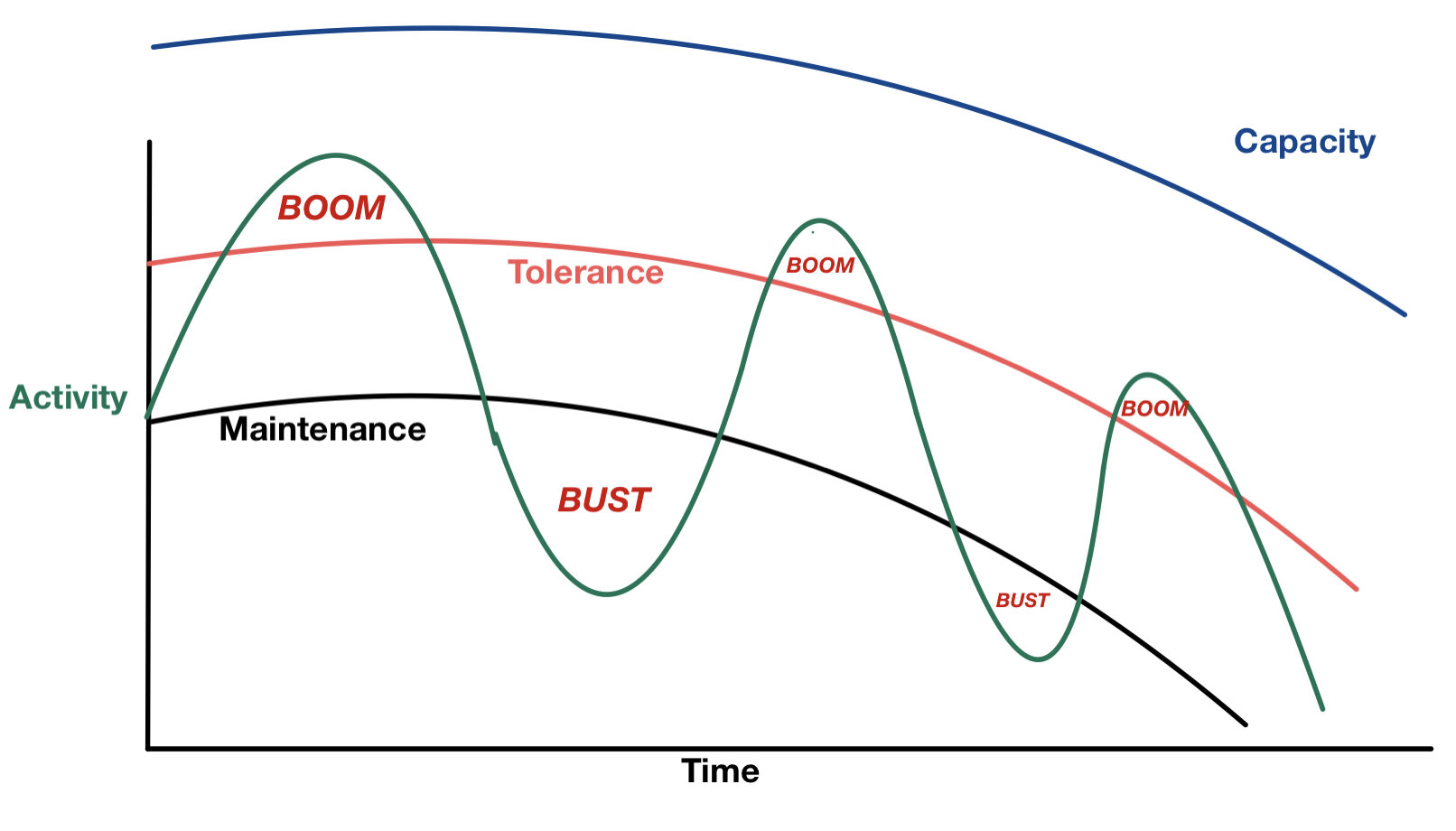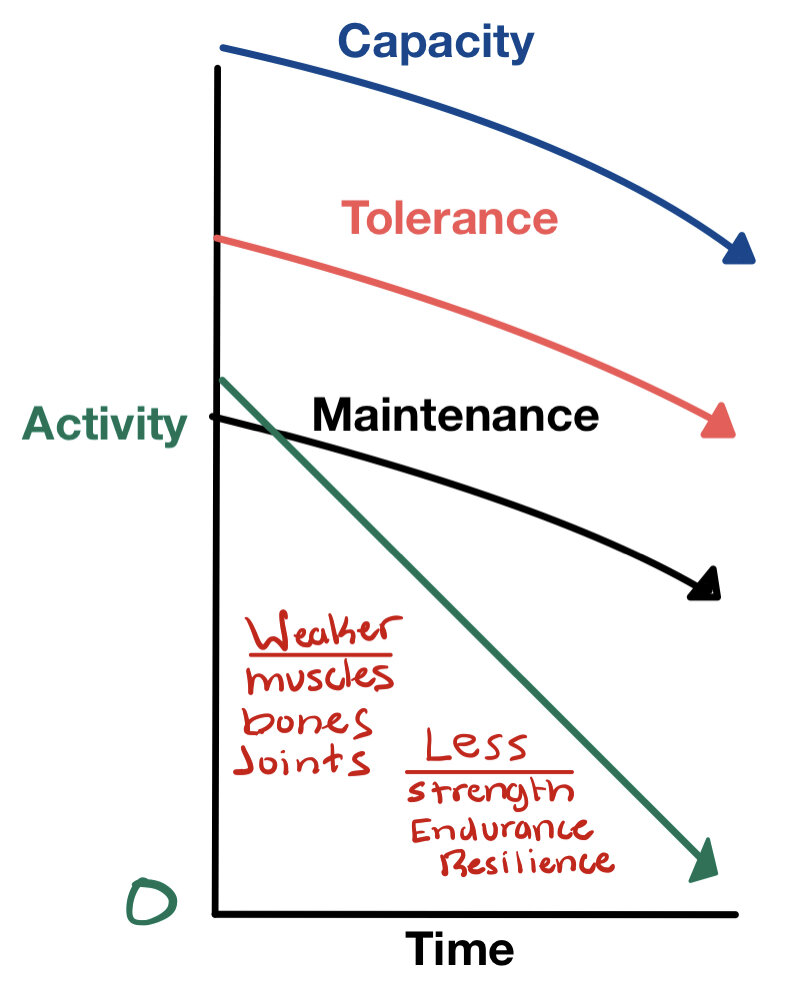Pain can feel like an absolute roller coaster. One day you are flying high, pushing through the pain, then the next few days your body crashes back down and won’t tolerate anything.
If you can clean the whole house or play 18-holes one day, but struggle to get out of bed the next, this is for you.
Let me introduce you to the Boom/BustCycle of Pain, and see if we can get those energy-sapping pain swings under control.
What is a ‘Boom’?
A boom is what happens when you fit loads of activity into a small window of time - normally fine, but when you’re dealing with a stubborn pain, sometimes this can result in a flare up of symptoms.
Oftentimes, people with pain will hold off on certain activities until the symptoms lessen, and then what happens?
You do everything. All at once. You might…
Type that entire report ✅ Mow the lawn ✅ Go on a run ✅ Carry all the groceries ✅ Footie with the kids ✅ Crush all your exercises ✅ Clean the whole house ✅
The thought process might be “I’ll get everything done now, and then I can rest and recover over the next few days.”
That’s when you BUST.
This man has clearly just done too much..
Your pain flares up from all the activity. You lay low and keep activity to a minimum to recover from all that effort and pushing through pain. So we DON’T…
Move as much 🚫 Exercise 🚫 Play with the kids 🚫 Carry any groceries 🚫 Walk 🚫 Do any house work 🚫 Sleep well 🚫
Essentially, you shut down and weather the ‘pain storm’, doing as little activity as you can get away with. Then, once the pain has somewhat settled, it’s time to get right back into it?
If you’re into graphs, the cycle might look something like this:
It’s really just two phases repeated over and over:
Boom - Doing too much too soon when it feels good (resulting in a pain flare)
Bust - Doing too little too long when it hurts (not enough activity to maintain your body’s capacity)
A Boom is when we violate our body’s “activity tolerance.”
Your body, let’s call it your shoulder, can handle a certain amount of load (or activity) at a given time. This is called capacity. If load > capacity, then something might snap, click, pop, or break.
Your body’s job is to keep you from exceeding that capacity. When it senses that you are getting too close, we could call that a tolerance violation.
If you’re dealing with pain, violating your activity tolerance usually results in more pain.
A Bust is when we dip below our body’s “maintenance requirement.”
Your body is really, really smart. It responds to everything you do - what you eat, how much you sleep, your thoughts, and definitely activity levels. There’s a reason construction workers are strong - because they use their strength all the time for work.
The thing keeping your shoulder (or back, neck, ankle, etc) at it’s current level of ability IS your current level of activity.
When you ‘bust’ from that short burst of activity and dip below maintenance, your body thinks, “well if I’m not using my shoulder as much, I probably shouldn’t keep it this strong.”
So both our “activity tolerance” and our “capacity” DECREASE.
This means it’s easier to actually hurt yourself (lower capacity) AND it takes less activity to create a pain flare (lower tolerance).
If you’re caught in a cycle of pain occurring, backing off, then reoccurring, your activity levels may need some adjusting.
This is where seeing a physio can be helpful. We’re really good at figuring out when and how you might be exceeding your body’s tolerance. We can help build your strength and capacity, and doing so without flaring up your pain.
If your pain swings from high too low and back again, here are three ways to begin getting your pain under control:
Step 1: Find your Baseline.
A baseline is a dose of activity that is more than nothing, but not high enough to flare up your pain. For some it might be as little as a few household chores, while others might be able to do more like a brisk walk or gardening. How much activity?
How do you know you’ve found your baseline? If you wake up the next morning and your pain is manageable.
For us, manageable usually means below a 5 out of 10 (where 10 = take me to the hospital).
Finding your baseline is important because it shows your body that you are capable of performing some activity without overloading the entire system.
Step 2: Use a Pain Scale.
Part of building a baseline is understanding what activities flare you up, and what activities are more manageable. We generally find that pushing through an activity where the pain is a 6/10 or higher is more likely to create a flare, while a 5/10 or lower is much less likely to do so. In fact, if you push through activities that are ≤ 5/10, there is good evidence that it will actually reduce your pain levels over time through a process called habituation. Example: if walking is a 4/10, but jogging is a 6/10, walking would be more helpful.
A quick pain scale reference:
<5/10 = there is some pain, but I can continue without it getting worse.
>6/10 = there is pain, and the more I do it the more intense it gets.
Step 3: Gradually Increase Activity.
It sounds simple, but restraint can be really challenging. Once pain is under control, people just want to dive right back into things! Lambs do it to, just look 👇🏼.
Remember our graph from before? This lamb made the same mistake most of us do - we just dive right back in. To make sure that our pain doesn’t flare up from doing too much too soon, our activity levels should look like a staircase - small increases over time.
Gradual increases over time gives your body enough time to adapt to the load, increase your tolerance, and build up your capacity needed to do what you want!
In essence, if your pain feels like a roller coaster, set a baseline and take the stairs.
These ideas sound simple, but getting them just right is hard.
If you feel like your pain goes up and down based on your activity, you might really benefit from seeing a physiotherapist. The Physio’s at Jenkins are experts in pain, movement, and activity, and can help you get you back to doing the things you love.
Take care,
Trevor McCracken
Doctor of Physiotherapy (Bond University)
B Sc Exercise Science











